-
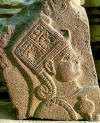 TransAnatolie 0601 TransAnatolie 0601
- 8 Day Cultural Tour in
Turkey
- Ankara, Black See, Cappadocia
Tour
-
For Pricing Click Here or
Contac Us
Cultural Heritage Tour to
Turkey: Kubaba1 & Hittites, Amazones & Black See, St. John Paul & Cappadocia
Day 1: Europe Ankara
Arrival in Ankara. Transfer to the
4 or 5 star high QoS hotel for the welcome cocktail, dinner and
overnight stay.
Day 2: Ankara
After breakfast at the buffet, our guide will
lead us to the
Anatolian
Civilizations Museum, prize-winning museum of the best Worldwide Museums in
1995. This visit will be preceded by a conference on the Anatolian civilisations. We
then visit the old part of
Ankara, the citadel, the Konak
Boyacizade, the Zenger Pacha
Ethnografical Museum and the Spice
Bazaar.
After lunch, we visit the Atatürk mausoleum and see his pictures exhibition recalling the main moments of his life and of the
constitution of the Turkish Republic. We walk through the Atatürk Forest, tasting ice creams,
a specialty of Atatürk Farm then go back to our 4 star hotel for dinner and overnight.



Day 3: Ankara Hattusas Amasya (376 km)
After breakfast we head towards the Kizilirmak Valley, up to the
capital of the Hittite Empire Hattusas and his pantheon Yazilikaya,
now registered as a National Historical Park. The main sites to be visited date back from the last period of the great
Hittite Empire. On the way to the park, we can see the big temple at Asagi
Sevir (temple n°1), the city walls with the colossal doors (Gate Arsanli
with its lions, Gate Poterni and YER, Royal Gate Kral). In Yukari Sevir, we can admire the 31 temples built on the edge of
Nisan
Hill, and the Royal Palace, the Big Castle and other
buildings.
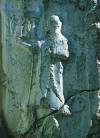
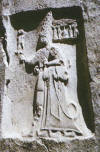
The open-air Temple of Yazilikaya, last remaining of the Hittite
Empire period is located at 5 km north-east of Bogazköy. It was made of
two rooms: the small and the large gallery, and was built taking advantage of
the natural placing of the local rocks.
Goddesses cut from the living rock are depicted on the right wall of the
large gallery, while an image of gods are shown on the left wall. Those two groups bring us to the rear wall, the most important one, that
shows us the meeting of the God of Time Tesup and his wife Goddess Hepatu.
In a local village, breakfast will enable us to appreciate an Hittite
menu, regional meal prepared with spices dried by the wind of the High Hittite
Plateau.

In the afternoon, we head up to Amasya, place of birth of the famous
geograph Strabon (1st century before JC) and centre of education for
the Ottoman princes. Our charmed hotel in Amasya, Apple-Tusan Grubu **** is waiting for us.
At sunset, hike trough Yesil Irmak Valley, taking pictures of wooden
houses Yolboyu of Amasya, known for their Ottoman architecture.
Dinner and overnight in our hotel.

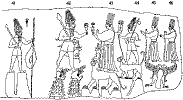
Day 4: Amasya Zile Cekerek Bogaziliyan Cappadocia (330
km)
After the breakfast at the buffet, we explore the city of Ferhat and Sirin,
also known under the name of City of the Crown, Amasya.
 We admire the old houses, Hazeranlar Konagi, the Ethnografical
Museum, the royal rot-cut graves dig dating back from the Hellenistic
period, without forgetting the Castle of Amasya, the Mosque with
the turning minaret Burmali, the Bayezit II Mosque and its medrese Kulliye, and the
Medrese Gök, the bridges (Caglayan, Alcak,
Kus), Darussifa-Bimarhane (psychiatric hospital). The museum of Amasya, one of the richest in Turkey, displays more than
27,000 objects, remainings from 11 civilizations. We admire the old houses, Hazeranlar Konagi, the Ethnografical
Museum, the royal rot-cut graves dig dating back from the Hellenistic
period, without forgetting the Castle of Amasya, the Mosque with
the turning minaret Burmali, the Bayezit II Mosque and its medrese Kulliye, and the
Medrese Gök, the bridges (Caglayan, Alcak,
Kus), Darussifa-Bimarhane (psychiatric hospital). The museum of Amasya, one of the richest in Turkey, displays more than
27,000 objects, remainings from 11 civilizations.
Lunch in a local restaurant.
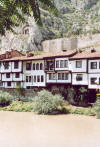
In the afternoon we drive across Turhal-Zile, visiting the Zile
Castle, place of wars between the Roman and the Bridge inhabitants , also known
for the famous quotation of Julius Caesar: "Veni, Vidi, Vinci".
Then we head towards Cekerek, Sorgun and Bogaziliyan, and one of
the most spectacular landscapes in the world: Cappadocia.
Dinner and Overnight in our hotel ****: Burcu Kaya- Dinler- Tassaray-
Kaymakli Prens.
Day 5: Cappadocia
After breakfast, we visit the old houses of Ürgüp. Start towards the Rose Valley, the
Camels Valley, the Valley of the Virgin
Mary. Then we enjoy a relaxing programme aiming at discovering different craft
industries (weaving and knotting of carpets), the nomad culture and imperial
palaces.
Lunch enables us to taste the Cömlek Kebab, specialty of the region
in a restaurant offering a beautiful view on the Kizilirmak River. In the afternoon, we first visit the underground city of
Ozkonak or Derinkuyu,
and we contemplate the strange and beautiful landscape of Cappadocia with
the old small village, so quiet and so pittoresk, of Mustafapasa, known
previously under the name of Sinasos. We continue by the valley of Cemil-Taskinpasa-Soganli
from the two regional architects, by the Hasan and Erciyes volcanoes.
Lets admire the hand-made poppies with linen in Soganli, and
especially the gloves and socks with Anatolian drawings.
Dinner and overnight in our hotel.
Day 6: Cappadocia-The Holy Land of Christianism; following the
Apocalypse of St. J. Paul
Hikes through the Valleys of the Three Cappadocian Graces, Üc
Güzeller, the Pigeon Valley, Uchisar, Avcilar. Stop in an Onyx
fabrique. Lunch at the hotel or at the buffet of the restaurant Koru.
In the afternoon, we visit the Göreme Valley, the open-air museum
surroundered by churches, admiring quietly at sunset the early Christian art,
the Byzantine Imperial art of those churches:Tokali-Elmali-St Basilius, Yilanli-Sandal along with the monasteries of priests and
priestesses, a unique religious campus, the place where the apostles, the first
Christians, the fourty Cappadocian Great Fathers, Saint Paul, Saint
John, Saint Timothy, Saint Barnabe, Saint Naziane
and Saint Basilius were welcomed, took refuge and prayed.
Diner and overnight at the hotel.
Day 7: Cappadocia Ankara (320 km)
After breakfast we take advantage of free time to walk over Pasabag, a
part of the famous Zelve Valley. We are in the country of Moutons
retournés. On the way to Kayseri, also known as Caesarea
during the Roman time, those who wish it can visit the leather factory.
Lunch enroute. Next to the Byzantine fortress, we can admire the Huant Medrese, and
its Archaeological Museum and the Mosque Honat Hatun. In the south of this complex, we find
Döner Kümbet, the very simple
and classic Seljukian Mausoleum ((1276), the first Seljukian school of Anatomy
and the Museum of Medical History Gevher Nesibe.
Lets also admire the delicate Sahabiye Medrese and by walking across the
Central Place and Bedesten, the Large Mosque Ulu, overlooked by a high minaret. We leave for Ankara, going through the High Plateau of Central Anatolia.
Dinner and overnight in our hotel.
Day 8: Ankara
After breakfast, some free time given to enjoy the city at your own pace. Transfer to airport for return flight for a nostalgic departure but eager to
live again this experience.
Pricing
Options
- During the Cappadocia tour, a Turkish evening with traditional dances and
Mevlevi performance
- Discovery of Cappadocia in hot air balloons
Inclusive
- 8 days/7 nights full pension
- Transportation in Turkey
- Lunches in traditional Turkish restaurants, one of the best cuisines in the
world.
- All admission fees to the museums and sites mentioned
- Guide
Exculisive
- Europe/Istanbul/Europe Flights
- Insurance, Airport Tax
- Drinks & Tips
Acemhoyuk
Top|
Further
Information|
Reservation |For
Pricing Click Here
1Kubaba
Kubaba
is the chief goddess of the Neo-Hittites, she became Cybebe to
the Phrygians and Cybele to the Romans. She was known as Kybele
in Anatolia
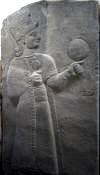 Kubaba
(in the Weidner "Chronicle"), also known as Kug-Baba
or Kubau, is the only queen on the Sumerian king
list. Before overthrowing the rule of En-Shakansha-Ana
of the 2nd Uruk Dynasty and becoming monarch, the
king list says she was a tavern-keeper. Kubaba
(in the Weidner "Chronicle"), also known as Kug-Baba
or Kubau, is the only queen on the Sumerian king
list. Before overthrowing the rule of En-Shakansha-Ana
of the 2nd Uruk Dynasty and becoming monarch, the
king list says she was a tavern-keeper.
"The house of Kubaba"
is mentioned "in the reign of Puzur-Nirah, king of
Akshak" (line 38) in the Weidner "Chronicle", a
propagandistic letter attempting to predate the
shrine of Marduk to an early period: "Kubaba gave
bread to the fisherman and gave water, she made him
offer the fish to Esagila" (line 43). Her reign as
the only "king" of the 3rd Dynasty of Kish was one
of peace and prosperity. Her reign is contemporary
with the "Early Dynastic III" period of Sumer. Her
reign is listed to have lasted for 100 years. If she
is a historical ruler, she probably lived in the
23rd to 25th century BC.
Shrines in her
honour spread throughout Mesopotamia.[1][2]
In the Hurrian area she may be identified with Kebat,
or Hepat, one title of the Hurrian Mother Goddess
Hannahannah (from Hurrian hannah, "mother").
Abdi-Kheba (= the servant of Kheba), was the palace
mayor, ruling Jerusalem at the time of the Amarna
letters (1350 BC).
Kubaba became
the tutelary goddess who protected the ancient
Syrian city of Carchemish on the upper Euphrates, in
the late Hurrian Early Hittite period. Relief
carvings, now at the Museum of Anatolian
Antiquities, Ankara, show her seated, wearing a
cylindrical headdress like the polos and holding a
circular mirror in one hand and the poppy capsule or
pomegranate in the other. She plays a role in Luwian
texts, and a minor role in Hittite texts, mainly in
Hurrian religious rituals. According to Mark Munn
(Munn 2004), her cult later spread and her name was
adapted for the main goddess of the Hittite
successor-kingdoms in Anatolia, which later
developed into the Phrygian matar (mother) or matar
kubileya[3]
whose image with inscriptions appear in rock-cut
sculptures.[4]
The Phrygian goddess otherwise bears little
resemblance to Kubaba, who was a sovereign deity at
Sardis, known to Greeks as Kybebe.[5]
Notes
-
^ The
Weidner "Chronicle" mentioning Kubaba
from Grayson, A.K. (1975) "Assyrian and
Babylonian Chronicles"
-
^ Munn, Mark
(2004). "Kybele as Kubaba in a Lydo-Phrygian
Context": Emory University
cross-cultural conference "Hittites,
Greeks and Their Neighbors in Central
Anatolia" (Abstracts)
-
^ Munn, 2004
-
^
C.H.E.Haspels, The Highlands of Phrygia
1971, I 293 no 13, noted in Walter
Burkert, Greek Religion, 1985, III.3.5
notes 17 and 18.
-
^ Herodotus
5.102.1, noted by Munn 2004
|
 Kubaba
(in the Weidner "Chronicle"), also known as Kug-Baba
or Kubau, is the only queen on the Sumerian king
list. Before overthrowing the rule of En-Shakansha-Ana
of the 2nd Uruk Dynasty and becoming monarch, the
king list says she was a tavern-keeper.
Kubaba
(in the Weidner "Chronicle"), also known as Kug-Baba
or Kubau, is the only queen on the Sumerian king
list. Before overthrowing the rule of En-Shakansha-Ana
of the 2nd Uruk Dynasty and becoming monarch, the
king list says she was a tavern-keeper.












